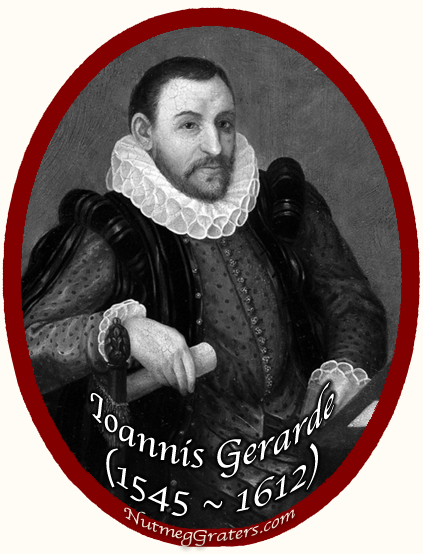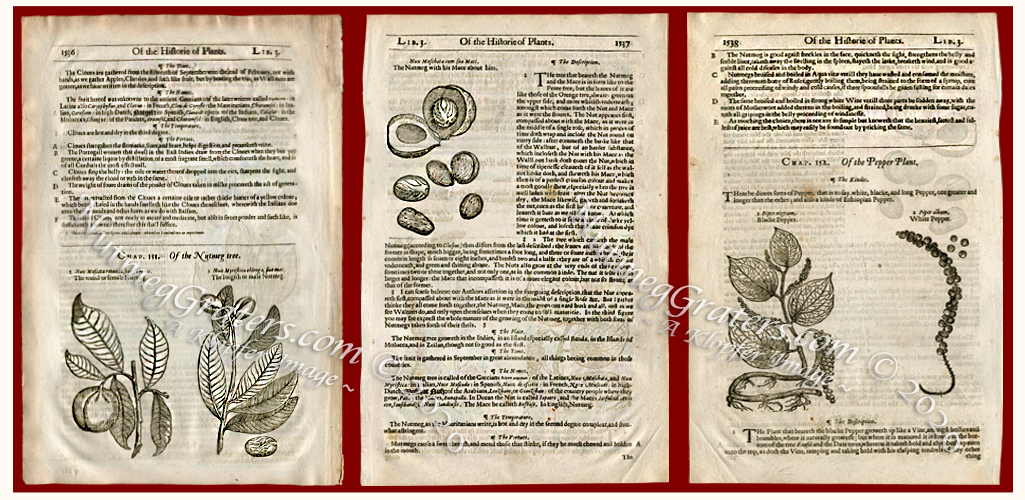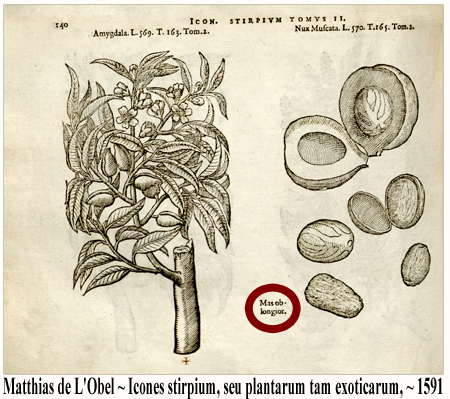NutmegGraters.Com



Chapter 151. Of the Nutmeg tree.
"1 The round or female Nutmeg."
"2 The longith or male Nutmeg."
" The Nutmeg with his Mace about him."
~ 1636 ~ Gerarde ~ The Herball Or Generall
Historie of Plantes
PRINTS: 1.The round or female Nutmeg. / 2.The longith or male Nutmeg. / {3}The Nutmeg with his Mace about him.
TEXT TITLE: Chap 151. Of the Nutmeg tree. (Pages 1536 - 1538).
SOURCE: The Herball Or Generall Historie of Plantes: Gathered by Iohn Gerarde of London Master in
Chirurgerie very much enlarged and amended by Thomas Iohnson citizen and apothecarye of London. Volume 3.
AUTHOR/CREATOR: John Gerard (Gerarde).
EDITOR (1636 Edition):
Thomas Johnson.
PUBLISHER: Adam J Slip, Joice Norton & Richard Whitakers, London.
DATE OF PUBLICATION: 1636 Edition.
SCOPE AND PURPOSE OF PUBLICATION: This is a medical herbal text.
PRINT METHOD: Xylography (wood block printing) uncolored.
PAPER TYPE: Chain Laid Paper without watermarks; sheet size W. 8½" (21.5 cm) x L. 13¼" (33.5 cm).
HISTORY:
[The Herball Or Generall Historie of Plantes (PART 1: 1597 / PART 2: 1636) ] ]
In 1597, Joannis Gerarde (1545~1612) published his first edition of The Herball Or Generall Historie of Plantes, the monumental text having 1484 pages. In 1612, while working to expand his work into a much larger second edition of The Herball Or Generall Historie of Plantes, Gerarde died. His death required the appointment of Thomas Johnson (Circa 1595~1644) to complete this project and in 1633/1636, the second edition of The Herball Or Generall Historie of Plantes was published in two volumes, now containing 1630 pages, plus its 20 page index.
Comparing the written content between the 1597 ant the 1636 chapters "Of the Nutmeg tree", other than a few text additions to the first paragraph in the second edition, the narrative remains the same between both works. However, the "nutmeg" woodblock engravings featured in Gerarde's first edition of 1597 differ from those used within the second 1636 edition. Both the first edition : Chap. 145. and the second edition : Chap 151. of Gerarde's works are checkered throughout with factual inaccuracies ~ fallacies within both the engravings and the textual evidence.
INACCURACIES:
Spurious Description:
Regarding "Of the Nutmeg tree", the erroneous 1597 Gerarde text was carried over into the 1636 edition. The text is largely factitious, containing meager factually information.
Spurious Illustrations:
The 1636 edition of The Herball Or Generall Historie of Plantes contains three woodblock images which replaced those used within the 1597 edition. Their associated captions read: ""I Nux Muʃcata rotunda, ʃiue fæmina. The round or female Nutmeg."; "2 Nux Myriʃtica rotunda oblonga, ʃiue mas. The longiſh or male Nutmeg."; and 3 "Nux Muʃchata cum ʃua Maci. The Nutmeg with his Mace about him." All three woodblocks are derived from other publication. Although somewhat more accurate in detail than those from the 1596 edition, these images remain factually and pictorially incorrect:
~ Image "1." depicts the fully unripened "fruit" and "leaves" from a female
 tree of Nux Moschata (Myristica Moschata); however, these trees
tree of Nux Moschata (Myristica Moschata); however, these trees
are ever-bearing throughout each year, and therefore an accurate
image would also include flowers, developing small fruit, and the fully
ripened split-open fruit (all simultaneously present throughout an entire year).
~ Image "2." incorrectly substitutes a "cousin tree": Warb. Myristica argentea
(also called Macassar nutmeg, Papua(n) nutmeg, silver nutmeg, but
most commonly known as the "long nutmeg"). Worldwide, there are
dozens of different myristica species (most non-spice bearing) which are
dissimilar to the Myristica Moschata. Although the "long nutmeg" has-
spice-like properties similar to Myristica Moschata, it is not indigenous to
the same locations as "Myristica Moschata", it is not of the same shape,
nor is it as flavorful. An accurate image for a male Myristica Moschata
tree is fruitless, but does produce the flowers necessary to cross pollinate
to the flowers of the female tree, which must occur for any fruit to develop
upon a female tree.
~ The third woodblock image duplicated in Gerarde's 1636 edition (SEE ABOVE:
![]() Page 1537) is derived from three earlier works by Matthias de L'Obel:
Page 1537) is derived from three earlier works by Matthias de L'Obel:
Plantarum seu Stirpium Historia, Page 570, (1576); Plantarum seu
Stirpium Icones, V.2 (1581); and Icones stirpium, seu plantarum tam exoticarum, quam indigenarum, in gratiam rei herbariæ studiosorum
in duas partes digestæ. Cum septem linguarum indicibus, ad diuersarum nationum vsum, Page 140, (1591) (SEE RIGHT: Page 140). All of these
images correctly illustrate the varied parts of the nutmeg fruit. However, in
the Gerarde (1636) rendition there is absence of the crucial, identifying text ~ "Mas ob-longior." [For ease in
observation, notice that NutmegGraters.Com highlighted these crucial words within the L'Obel print, encircled in red.] Among all L'Obel publications, he clearly is identifying that there are two distinctly different species of "nutmeg": [one being Myristica Moschata, the "round nutmeg" or the "true nutmeg"; and the other Warb. Myristica argentea ~ "Mas ob-longior", translating as "long nutmeg".] The L'Obel's woodblock were pictorially created to educate readers that these two spices are not identical, differentiating that Myristica Moschata, the "round nutmeg" or "true nutmeg" is indigenous from the Banda Islands and vicinity, while Warb. Myristica argentea, the "long nutmeg" originates elsewhere ~ being commonly traded at Ceylon (now Sri Lanka), the large island off the southern coast of India. L'Obel highlights these as difference spices, because there was confusion between the two. When compared against Myristica Moschata, Warb. Myristica argentea, "Mas ob-longior" is significantly inferior in quality; lacking in taste, essential oil and general usefulness. During the 16th century, unscrupulous traders often misrepresented the better quality "round nutmegs" by substituting "long nutmegs" instead; or, by mixing the less desirable and less valuable "long nutmeg" together with the better quality and highly valuable "round nutmeg" ~ deceptively sold as the "true nutmeg" to enhance profits from those unknowledgeable about these differences. L'Obel sought to inform the public. Oddly, the 1636 edition of The Herball Or Generall Historie of Plantes omits to differentiate the "round nutmeg" from the "long nutmeg" as intended within L'Obel's original woodblock carvings ~ thus by omission, perpetrating the public's inexperience to distinguish nutmegs Myristica Moschata from Warb. Myristica argentea.
[KLOPFER article © September 2020 & January 2021]